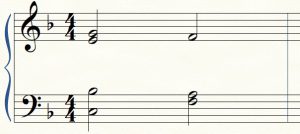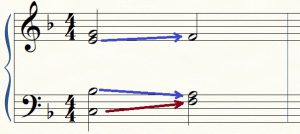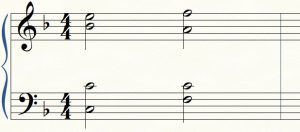DOMINANT 7th CHORDS
Now we are going to look at one of the most important and useful chords out there… the DOMINANT 7th CHORD!! This is so useful because it naturally leads to a resolution and makes the phrase of music sound finished.
In any key, the fifth tone of a scale is called the dominant of the scale. So, in the key of F, the notes of the major scale are: F-G-A-B flat-C-D-E-F. The fifth note of that scale, or C in this case, is called the dominant. A later post will explain some of the reasons that the dominant tends to lead next to the root of the scale, but suffice it to say now that it just has a natural and pleasing sound moving from the fifth tone to the root of the scale. This is also written with Roman numerals as V-I.
In any key, the four-note chord built on top of the dominant note has a flatted 7th tone. Look at the fifth chord in the following progression, and notice that the fifth chord has a G-B-D-F. If played alone, this is a major triad with a flatted 7th.
Now let’s just pull out the key of F major. Look at this example of a dominant seventh chord, resolving to the root…
You can see the first chord is a C7 chord, but spread out over the staff. The notes are C-E-G- and B flat, which is a C chord with a flatted 7th, or in other words, a C7 chord. C is the fifth tone of an F major scale, so this C7 chord is a dominant 7th chord in the key of F. The progression from a dominant 7th chord to a root chord is also written in Roman numerals as V7-I.
The power of this chord is that each of the notes very naturally and easily moves to a certain tone, creating resolution from tension. In fact, when you hear a dominant 7th chord, your brain automatically wants and expects to hear a root chord after it! The dominant of a scale pulls towards the root, so in this case, the dominant C will move up to the root F.
Music notes are a little bit lazy also, and like to move as little as possible. So, when you have notes that only have to move up or down a half step, they are happy! The B flat here will slide down to an A, and the E in the treble clef will slide up to an F…
You will notice that in the final F chord, the C is missing. It is okay to omit the fifth of a chord, as it still sounds resolved with just the root and the third. If we readjust the V7 chord, we can get a fuller root chord at the end, but in order to do that, we have to omit the fifth tone from the V7 chord…
Notice how the G is missing from the C7 chord? Again, the chord can still achieve its effect when you only have the root, third, and 7th of the chord. If you put it in this format, though, you are able to resolve to a fuller F chord, with the root, third, and fifth all in place! This is very useful in resolving the tension in the music for a beautiful and pleasing piece. Next time we’ll talk about the amazing diminished 7th chords. Until then, keep practicing!!
And the beat goes on…







You must be logged in to post a comment.